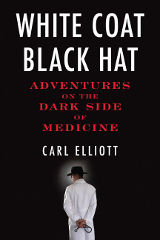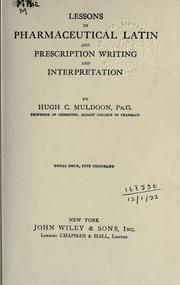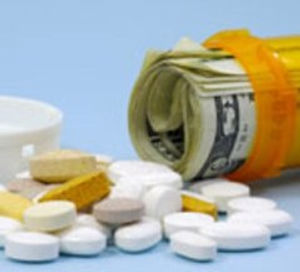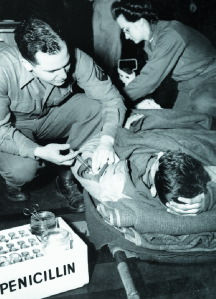Pharmaceutical Suspicion
- Joseph Gabriel
- Nov 16, 2011
- 9 min read
Updated: Aug 30, 2023
Michele Bachman’s implosion on the campaign trail back in late September is now widely accredited to her suggestion that the HPV vaccine causes mental retardation. In an earlier post, I argued that pundits should think twice before dismissing Bachman due to her position on this topic, and while Bachman’s campaign collapsed a lot more quickly than I expected, I continue to think that her arguments about vaccination were potent ones.
"La Vaccine Mort en Avortant de Son Dernier Monstre," ca. 1800
There is a deep distrust of the pharmaceutical industry running through much of American culture – indeed, a Harris Poll last year found that just 11% of Americans consider pharmaceutical companies “honest and trustworthy,” a remarkable finding given that virtually all of us place the products of these companies in our bodies and many of us literally depend upon them for our lives. The idea that the drug companies are deceitful and, perhaps, predatorial is widespread, stretching from the halls of academia to the claims of Scientologists, from right wing populists to the Rainbow Family, from alternative health care practitioners and their allies in the New Age and health food movements, to patient advocacy groups, anti-psychiatrists, and more. Even libertarians, who usually trust just about anyone able to make gobs of money, exhibit a certain skepticism of the pharmaceutical industry when they start talking about legalizing marijuana and other drugs. So what’s going on here?

Elliott: White Coat, Black Hat (2010)
In recent years, Big Pharma has been repeatedly caught acting badly – suppressing and manipulating scientific data, engaging in illegal marketing, and other obnoxious and dangerous practices. Critics of the industry tend to assume that these sort of things are new, and that they point to a relatively recent decline in ethical behavior on the part of the industry over the past three or four decades. (For example, see Carl Elliott’s excellent and quite disturbing recent work on the industry, White Coat, Black Hat.) That’s highly debatable – in my own scholarly work I have found examples of very similar practices dating back to the 1880s – but the overall implication of the argument is worth considering: a significant decline in ethical behavior on the part of the industry, resulting in a large number of highly publicized scandals, may be one of the drivers of the broad suspicion of the industry in popular American culture.
I think there is a lot of truth to this argument. Bachman’s wild accusations were powerful in part because they reflect, in a rather distorted way, what a lot of Americans intuitively know – that pharmaceuticals are powerful substances, that they can harm as well as heal, and that drug companies can not always be trusted to tell us the truth about their products. Public accusations of industry malfeasance – such as the 2004 accusation by Eliot Spitzer, then New York’s attorney general, that GlaxoSmithKline committed fraud by suppressing negative information about Paxil – are almost certainly an important source of what I have begun to call “pharmaceutical suspicion” – the broad, deep, and persistent distrust of the pharmaceutical industry in popular, political, scientific, and medical discourses.
Still, the breadth and persistence of this suspicion indicates that there is more going on here than simply a reaction to recent events. I’ve been working on a book on the history of the pharmaceutical industry for the past several years, and one of the conclusions I have come to is that public distrust of the industry has very deep roots in popular American culture. So, with that in mind, what I’d like to do here is simply outline some of my ideas about the origins of this widespread distrust toward the industry – in part to help organize my thoughts for a talk I’m giving on the topic next week, and in part to get your thoughts on the argument. So please feel free to tell me where this analysis falls down. If nothing else, you will help me avoid making a fool of myself in front of a roomful of very smart people.

Then as Now: A Secret Language for the 1%
To begin with, distrust of medical science is nothing new. As I argued earlier, Bachman’s attack on the HPV vaccine drew on a long history of suspicion of orthodox medicine. During the first half of the nineteenth century, this suspicion erupted into a variety of popular health movements that criticized orthodox physicians as greedy and monopolistic – the practice of writing prescriptions in Latin, for example, was criticized as being an intentional effort to keep medical knowledge from ordinary people. At the same time, from the perspective of orthodox physicians, medical science and the pursuit of profit were conceptualized as distinct and mutually exclusive categories: orthodox physicians considered it unethical for drug manufacturers to commercially introduce new products until they were determined to be effective by the medical community; so-called “ethical” manufacturers were only supposed to deal in goods that were known to be effective, they were not supposed to monopolize their products through the use of patents or secrecy, and they were not supposed to include therapeutic claims in their advertising or advertise to the public. Drug companies that did so were attacked as unethical and quackish by orthodox physicians – the nineteenth-century medical literature is filled with attacks on so-called “patent medicines” – and as a result medical science was rhetorically distinct from the pursuit of profit within the orthodox medical community.
For much of the public, however, patent medicines were highly popular and the orthodox medical critique of them was just another example of medical elites working to suppress other forms of healing in order to line their own pockets. Indeed, from perspective of many critics, the buying and selling of “quack” medicines was a way to strike a blow against the monopolization of health by elite physicians. Samuel Thomson’s rallying cry against medical orthodoxy – “Every man his own physician!” – was both a sales pitch for his medical system and a populist cry of anger against medical elites. For Thomson, and his many followers, freedom from medical tyranny came through the buying and selling of an unorthodox medical therapy. For orthodox physicians, on the other hand, the suppression of quackery demanded the rigid separation of medical science and medical markets.
By the early twentieth-century this formulation had been radically transformed. Historians such as Martin Sklar, Jeffrey Sklansky, and James Livingston have suggested that what Sklar calls the “corporate reconstruction” of capitalism, c. 1890-1940, entailed not just economic and organizational change on the part of large firms but fundamental transformations in the intellectual, legal, political, and cultural landscape of the country as a whole. The ethical significance of relationship between medical science and medical markets was one important example of this. Between the collapse of Reconstruction and the outbreak of World War I, a wide variety of reformers in the medical, pharmaceutical, philanthropic, and regulatory communities successfully argued that medical science would be advanced, not undermined, by linking scientific drug development to the goals of profit. This was an exceedingly complex process, but at the heart of it lay the idea that corporate investment in the scientific process was necessary to the advancement of the drug discovery process and thus to the public welfare. This took a variety of forms – as I have argued elsewhere, for example, within the medical community patents were redefined from being an unethical form of monopoly to being a legitimate means of promoting medical science. A complex regulatory apparatus also developed during this period, but – despite the claims of some – it was neither “captured” by corporate interests nor hostile to the workings of industry; rather, it developed through a complex process of mutual negotiation between various interest groups, including regulators, industry scientists, and academic physicians, toward the goal of mutual cooperation and the promotion of corporate drug development. A third example: by the 1920s, academic physicians and other medical scientists researching new drugs were deeply intertwined with the pharmaceutical industry through the corporate funding of their work, joint research efforts, and other institutional mechanisms. In each of these cases, the logic of corporate profit was increasingly intertwined with the goals and methods of scientific drug development.
Now, for many observers, this blending of scientific, regulatory, and commercial concerns promised the development of powerful new drugs that would greatly benefit humanity. Yet for others, the increasingly close relationship between the three pointed not to the advancement of science but rather to its corruption. As a result, even as the goals of scientific progress and corporate profits were reconciled, a tradition of distrust in pharmaceutical science was established. We see here two important transitions:

A Very Cozy Relationship
First, orthodox physicians increasingly embraced the goal of corporate profit as a means of advancing both their own professional interests and the good of the public; at the same time, however, the long tradition of popular suspicion of medical elites was expanded to include a biting critique of the growing alliance between corporate profit and medical science. Thomson’s critique of medical orthodoxy as a form of tyrannical monopoly, and the embrace of the market as a means of asserting medical freedom, continued – but, increasingly, it blended in complex ways with a new tradition that saw corporate profit as itself one source of medical tyranny.
This was an extremely complicated process, and different actors involved responded to the changing landscape in different ways. Small manufacturers, for example, were frequently unable to meet the changing scientific norms that therapeutic reformers sought to enforce during this period – such as the use of clinical trials to demonstrate product efficacy – and many believed that medical elites (and, in particular, the American Medical Association) were conspiring with large drug firms to shut out smaller companies. Others critics attacked what they saw as the corruption of the regulatory process, suggesting that the Bureau of Chemistry, the Food and Drug Administration, the Federal Trade Commission, and other agencies were actively working to promote the interests of large manufacturers at the expense of smaller companies, or that they were working with the orthodox medical community to suppress alternate therapeutic systems such as homeopathy. “Many valuable methods of treating diseases have been demonstrated, only to be suppressed because, if introduced, they would interfere with the profits of established interests,” wrote one critic in 1934. “The same great pharmaceutical house will manufacture a biological treatment or remedy for the physician, which is of little or no value [but] these fakes are protected by the Federal Food and Drug Administration and the Federal Trade Commission!” These types of critiques continued in the years to come, and they played an important part in the development of a widespread, popular distrust of the drug industry and its supposed allies in both orthodox medicine and the regulatory communities. As one recent critic notes, in his pitch to try to get you to buy his book, “every decision that the Food and Drug Administration (FDA), the Federal Trade Commission (FTC), and the American Medical Association (AMA) make, will ultimately result in billions of dollars in profits for the drug industry. The management of each of these organizations is intertwined with the drug industry to the point that there are enormous conflicts of interest.”

Good Science v. Bad Science
Of course, critique of the industry did not disappear from the orthodox medical community. Even as medical science and medical markets were increasingly reconciled in the early twentieth-century, a tradition of suspicion within elite medical science remained. Many physicians, pharmacologists, and other scientists in the early twentieth-century were suspicious of working too closely with the drug industry. In many ways this was an extension of the earlier critique of markets as fundamentally corrupting on the scientific process, but rather than a wholesale rejection of the impact of the profit motive on medical science we see instead a binary emerge between “good” science, properly conducted and perhaps funded by drug companies, and “bad science” – science that has been corrupted by its funding source and is no longer legitimately considered truly scientific. From the perspective of orthodox medicine in the early twentieth-century, working too closely with the drug industry carried a certain risk, in that proper scientific practice might be distorted by the temptation to engage in unethical practices. As long as this tendency was closely watched, however, corporate investment in pharmaceutical science was clearly a good thing since it promoted the development of powerful new drugs.

Big Pharma Supports the Troops
Indeed, by the outbreak of World War II large drug companies such as Merck and Parke, Davis & Company were considered essential players in the process of scientific drug development – but, still, one had to be careful to make sure that such companies were acting ethically and did not succumb to the temptation to exaggerate their claims or otherwise distort the scientific process. This type of modestly suspicious attitude continued to characterize orthodox medicine’s response to the drug industry through the post-World War II era. Today, despite the widespread acceptance of industry funding and the assumed centrality of the industry in the nation’s system of health-care, the tradition of suspicion continues among elite orthodox physicians.
Clearly, I have only begun to sketch out a few strands of the story I am trying to tell here. There is a tremendous amount of work to be done tracing the history and significance of pharmaceutical suspicion. This is, I think, an important topic for scholars to start working on – distrust in pharmaceutical knowledge plays a tremendously significant role in how we think about health and debility, medical care, and medical authority. It shapes everything from the way we regulate the industry, to how we design and implement public health initiatives, to how we think about and treat diseases such as depression and ADHD. Indeed, it shapes the choices that we make about what we put in our bodies on an almost daily level – do I really want to take that drug my doctor prescribed, I ask myself, and will it actually help me feel better? Why does this pill cost so much money? Are there side effects nobody is telling me about? We cannot escape such questions when we think about and consume drugs. Pharmaceutical suspicion is part of who we are, and – just as with other aspects of ourselves – it is something that we need to understand and explore from a historical perspective if we are to make sense of the world in which we find ourselves.

We are the Pharmeceutically Suspicious
So… time to get back to work. Comments and observations are, as always, appreciated.
